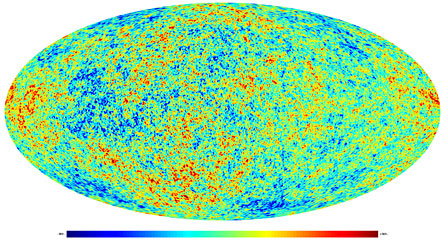Some people are loath to take a lopsided view of the universe, but cosmologist Sean Carroll and his colleagues are positively reveling in it. Embracing a study that suggests the pattern of radiation left over from the Big Bang looks surprisingly different from one side of the sky to the other, Carroll and colleagues have come up with some mind-bending possibilities to explain the puzzle, described in a paper posted online June 3.

In one scenario, the universe existed before inflation — the short-lived but enormous growth spurt associated with the Big Bang. In the other scenario, the universe is but a tiny part of a primordial structure now grown so big it exceeds the horizon of the observable universe.
Either way, the explanations suggest “that something outside our observable universe or before the period of inflation left a relic, left some imprint on what we can observe today,” says Carroll, of Caltech.
Inflation theory posits that during the first minuscule fractions of a second, the subatomic-sized universe swelled to something like the size of a grapefruit. The rapid stretching explains why widely separated parts of the universe appear so much alike. It also explains why the radiation generated during the Big Bang, known as the cosmic microwave background, is uniformly distributed across the sky.
Tiny temperature differences in that radiation signify the primordial seeds that ultimately gave rise to galaxies and galaxy clusters, but according to the simplest model of inflation the magnitude of those tiny hot and cold spots ought to be about the same over different parts of the sky.
However, that belief seems to be contradicted by a recent finding. An analysis of the cosmic radiation recorded by NASA’s Wilkinson Microwave Anisotropy Probe, or WMAP, shows that the temperature variations over half the sky appear to be about 10 percent greater than the variations in the other half, Hans Eriksen of the University of Oslo in Norway first reported in 2004. He says the asymmetry “looks quite significant, but one shouldn’t throw everything else overboard quite yet.”
WMAP theorist David Spergel of PrincetonUniversity says the finding is “certainly not at the level to make a convincing claim of an asymmetric sky.”
But taken at face value, an asymmetric sky poses a problem for the simplest model of inflation, notes Carroll. That’s where he and his Caltech colleagues Marc Kamionkowski and lead author Adrienne Erickcek come into the story.
Simply tweaking the theory doesn’t work, Carroll notes. But when his team added major modifications, the model reproduced the asymmetry seen by Eriksen.
One of those revisions posits the existence of a “supermode” — a primordial fluctuation in density so much larger than the universe that the fluctuation appears to look uniform. As Carroll notes in a recent blog, it’s as if the cosmos were sampling such a tiny piece of a sine wave that the wave looks likes a straight line instead of oscillating.
The neat thing about having a supermode, says Carroll, is that it must have originated before the period of inflation during which the tiny lumps were created that grew into galaxies. Either the supermode came from an even earlier period of inflation, or it preceded inflation entirely.
Inflation’s stretch “usually provides a veil between us and the pre-inflationary and/or superhorizon universe,” says coauthor Kamionkowski. But if the asymmetry in the microwave background is confirmed “and if our interpretation is correct, then it provides a window toward regimes of the early universe that we hitherto thought observationally inaccessible.”
The new work may also shed light on what sparked inflation in the first place. “What I’m happiest about with this new work are the prospects it opens up for learning more about the physics of inflation, how it got started and/or what happened before inflation,” Kamionkowski adds.
The European Space Agency’s Planck mission, set for launch this fall, will look at variations in the cosmic microwave background on finer scales than WMAP and should determine whether or not the asymmetry is real, Eriksen says.
Alan Guth of MIT, who first proposed the inflation theory nearly three decades ago, says he suspects “the reported lopsidedness will more likely turn out to be a fluke.” However, he adds, “the concept of inflation is really only the framework of a theory, and so far experiment has given us very little guidance in trying to fill in the details. The authors of this paper are doing just what is needed: they are taking a hint from the data and elaborating it into a theory.… It is only by pursuing such hints that … we will have a chance to find the right way to put meat on the inflationary skeleton.”







